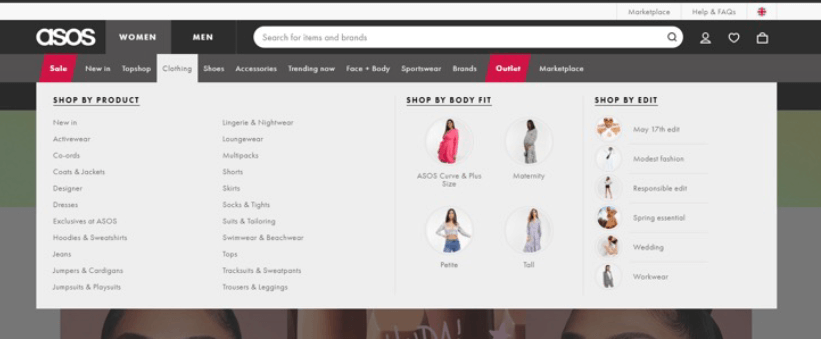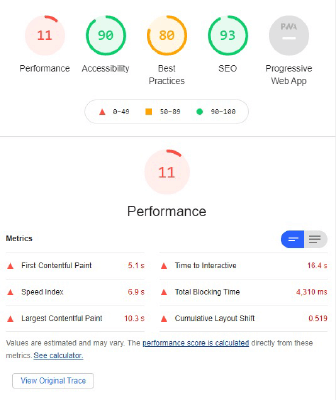Whether you’re an in-house marketer with no SEO knowledge or someone with years of experience in the industry, it’s vital to know the brand and its product offering like the back of your hand if you want your fashion SEO strategy to be successful.
As an external SEO agency marketer, I have to make efforts to understand my clients’ business needs, market and consumers if I’m going to bring in organic users that actually convert. I have planning meetings ahead of each new season with my fashion e-Commerce clients – it’s this that informs a large part of the content strategy. In these meetings, we usually cover the following:
- New and returning products from best-selling brands
- Any new brands launching on site
- The expected product delivery timeline
- Opportunities to expand the categories and subcategories used on site
- Trends for the season and opportunities for optimised clothing edits
- Successes and opportunities found from last season and last year
- Forecasts and key revenue drivers
Knowing all of this before I put together the season’s strategy helps me ensure I’m working in a way that aligns with my client’s own goals. With that in mind, here are some of the most useful tips I’ve picked up while working in SEO for fashion.
Choose Your Keywords Very Wisely
Unfortunately, selling dresses isn’t enough to rank for dresses on Google. With a monthly search volume of 165,000 at the time of writing, a SEMrush Keyword Difficulty score of 89.58% and almost 3.5 billion results on Google to compete with – in the vast majority of cases, it wouldn’t be a worthwhile use of resources to even try.

But you can steadily improve the organic visibility of your dresses and bring in a good return on investment whilst building up your site’s ability to rank for more competitive keywords in future. So how do you find the most valuable keywords to rank for?
Instead of asking what keywords you should go after, it’s better to ask which keywords will help the right people – those who want to buy your products – to find them.
- If you rank for keywords that aren’t a great match to your site and products you’re going to see high bounce rates and low conversions.
- And if you only go after keywords with informational intent, you’re going to see better engagement metrics, but still low conversions.
Put yourself in the mind of the searcher. It’s easy – chances are you’ve done a bit of online shopping yourself. If you had an image in your mind of the exact products your site offers, but you didn’t know where to find them, what would you type in the search bar? Optimise for that.
For example, ‘Gingham wrap dress’ has just 110 searches per month in the UK, but those 110 people know exactly what they’re looking for – and so they’re more likely to convert than the 33,100 searching for ‘Wrap dress’.
Remember that search volume is not everything. If I had the choice between ranking for 1,000 relevant keywords each with a monthly search volume of 10, or 10 relevant keywords each with a monthly search volume of 1,000, I’d go for the first option. Trends change all the time, SERPs can be volatile, and you don’t want all your eggs in one basket.
Sound like a minefield to keep on top of? A great tip is to keeping organised is to create a keyword map – my colleague Sophie Brannon recently wrote this blog on creating keyword mapping files, which is a fantastic resource for beginners.
Categorise Products Logically For Users & SEO
Whether you offer a small range of products or have an extensive inventory, sorting your products into user-friendly categories and subcategories is incredibly important. If you get this right, it will not only maximise your organic traffic, but increase conversions too.
Most physical clothing stores won’t have a regimented section for tops, another for knitwear, another for skirts and so on. People like to see how different pieces work together, and so visual merchandisers often create trend-based displays.
Online, your customers are in a completely different mindset. They usually have at least a good idea of what they’re looking for and they want to be able to find it as quickly and easily as possible. Organising your garments by type is the first step towards a user-friendly fashion e-commerce store.

Generally, it’s a good idea to create a different category for every type of garment that has a different name. It’s not a good idea to have one category, for example, for dresses and skirts that isn’t good for users or SEO. Sometimes, multi-categories can make sense where the lines are blurred – think jackets and coats, socks and tights.
Your categories will likely evolve over time, so it’s important to consider your future needs when setting up categories. You might not have the product offering to warrant subcategorising your jumpers by neckline shape now, but keep it in mind for future.

Pay Close Attention To Your Site Search
Following on well from the last point – your site search functionality is a gold mine. It’s like having a comments box where customers tell you exactly what you want. It’s a great opportunity to identify gaps in your product offering and respond to customer demand. And the data speaks for itself. Here’s an example from one of my fashion e-Commerce clients.
Not a lot of their visitors use the search function – less than five percent. However, those that do use it make up over 18% of the revenue, and their conversion rate is around triple that of visits without site search. In short, people using your search functionality are your most valuable customers.

But how can you maximise your search data? It’s straightforward. Start tracking your search results data as early as possible. Head to the Search Terms tab on Google Analytics and review everything that your customers type into your search bar. Notice something you don’t offer? There’s an opportunity to offer a new product, knowing the demand is already there.

Next up, put yourself in your customers’ shoes. Go to your site and type in the most popular search terms. Manually review the products that appear. Are there results a good answer to the query? Are there any items missing? Here, you have the opportunity to improve the products that are being shown to the segment of your website visitors that have the highest proven propensity to purchase.
Get To Grips With Faceted Navigation
Disclaimer: you’ll need a good developer for this one.
Allowing your visitors to filter and sort products based on product attributes is another way to offer a better user experience to those valuable customers who know what they want – those furthest along the customer journey, with purchase intent.

It’s a great idea to give your visitors the option to narrow down their search as much as possible. However, the more combinations of filters available, the more potential combinations of URLs, which can lead to duplicate content, wasted crawl budget and messy analytics, amongst other issues.
For this reason, you need to ask the developer to ensure filters are applied to the URL in the same order every time (so there’s only one version of each possible URL), and to create rules to no-index any URLs with more than two filters, or with filters that don’t match search intent (such as size ranges).
All ‘filter’ URLs should be set up to automatically have a canonical tag pointing to the closest non-filter URL. For example /shoes/red/ would have a canonical tag pointing to /shoes/. This will prevent duplicate content issues. If you choose to add unique content to the page about red shoes, because this is a term you decide you want to rank for, the canonical tag should be updated to a self-referencing one.
Having your site set up in this way will allow you to place optimised content on the most relevant page possible, which in turn makes the page more likely to rank well in the SERPs. What’s more, if organic users land on the page and find products that perfectly match what they’re looking for – well, they’re more likely to make a purchase.
Offer The Best User Experience Possible
Just as you would make a bricks and mortar shop as welcoming as possible, ensuring your users actually enjoy being on your site is the number one way to encourage purchases. There are two main ways you can test the user experience on your site.
Step 1: Gain the perspective of a user. It can be a little tricky to separate yourself from the site, especially if you’ve put lots of work into making it the way it is. Ask a friend or colleague to browse the site and make a purchase. Ask them the following questions:
- What do you think of the brand as a result of your experience on the website?
- How easy or difficult was it for you to find products to purchase?
- Was all the information you needed about the products and service (e.g. delivery charges and fees) easy to find?
- Was the site responsive or slow?
- Is there any extra features you wish the site had?
- Did you encounter any frustrations?
- How was the checkout process?
Step 2: Check Google’s Lighthouse Performance score. Here’s how
- Open the site in an incognito tab.
- On Windows, press F12 to open the developer console. On Mac, click ‘Help’ in the menu bar, then select Developer tools
- At the very top, click >> and select Lighthouse
- Click generate report.
You can choose to run the report on mobile or desktop – I recommend mobile because Google will index your site as the mobile version. You can also check in Google Analytics to see what ratio of your visitors use mobile or desktop (Audience > Mobile > Overview).
This will show you a performance score out of 100. It uses a traffic light colour coding system, and is easy to follow. I will say here that I have checked the Lighthouse report of a dozen large fashion sites on page one for competitive keywords, and the highest Performance score I found was 11.

You can choose to look at this as it being okay to have poor performance, because the entire industry does, or you can look at it as an opportunity to get ahead of your competitors with the rollout of Core Web Vitals coming up very soon.
Two quick-win opportunities to improve your site from a user experience and site performance perspective are:
- Optimise all of your images – you can do this without losing any of the image quality. A great free tool is seopix.io
- Consider whether your site really needs dynamic elements such as carousel banners and popups, which add a lot of JavaScript to the page, and can sometimes be frustrating for the user
Summary
While I’ve written this piece specifically about my experience in fashion SEO, most of the issues and solutions are common across many e-Commerce sites. Whatever industry you’re in, remember that optimising your site is a marathon, not a sprint. It’s important to strike a balance between quick-win opportunities to show the value of your SEO strategy and nurturing a long-term growth strategy for your online presence.
Going back to my original point about understanding the business and its customers – SEO isn’t about getting your brand in front of as many people as possible in the hopes that some of them will convert. It’s about knowing exactly who your ideal customer is and optimising your site to make it easy for them to find and use. Contact us to discuss how partnering with a leading digital marketing agency can help, today.
 Contact Us
Contact Us Contact Us
Contact Us







